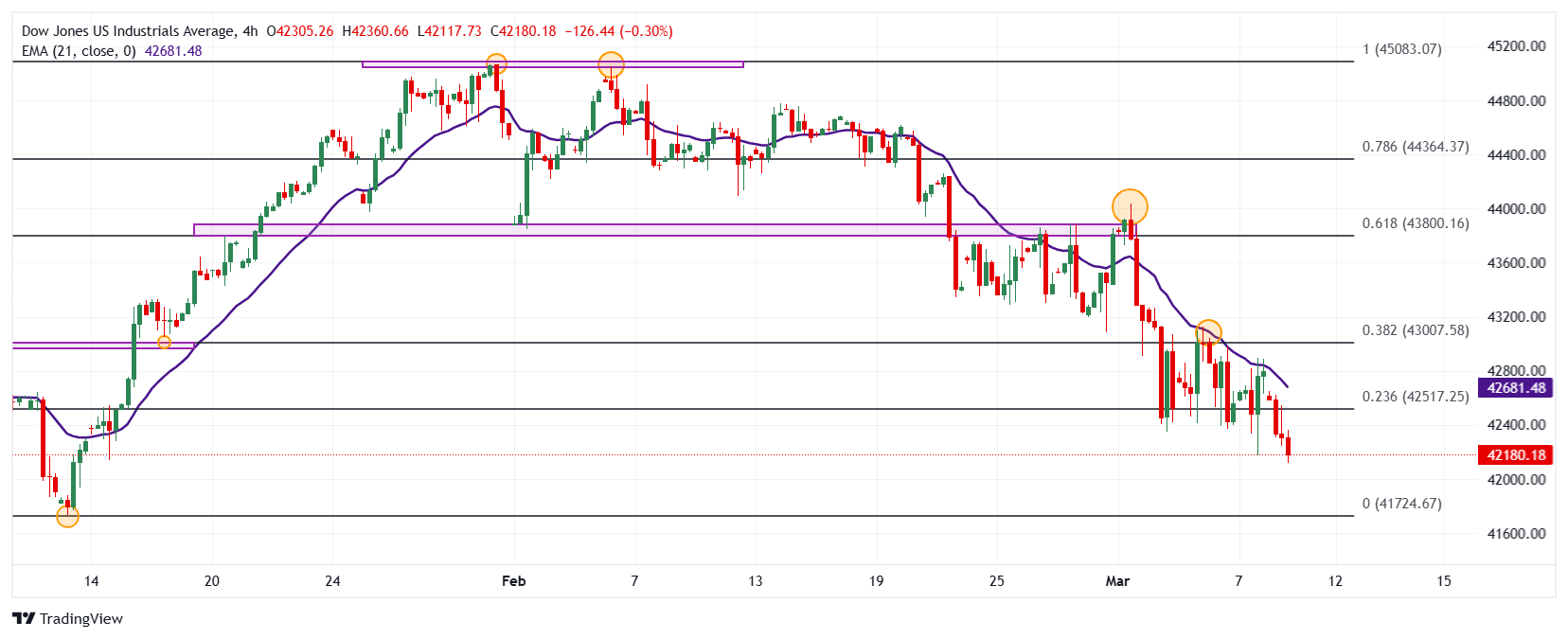- Dow Jones loses 1.56% in the day.
- The Nasdaq 100 collapses 3.38% today, dragged by Microstrategy Incorporated (Mstr).
- The S&P 500 falls 2.13% daily, reaching minimum of almost six months.
- The focus of investors will be on the United States consumer price index, to be released on Wednesday, March 12.
The Dow Jones marked a daily maximum in 42,647, attracting aggressive vendors that dragged the index to a minimum of the day in 42,117, reaching minimum of January 13.
The Dow Jones industrial average opened at 42,615 while the Nasdaq 100 technological index began operating in 20,140. The S&P 500 began negotiations in 5,746, sliding strongly until reaching minimal not seen since September 2024.
The Dow Jones loses more than 600 points weighed by Apple and Goldman Sachs
The Dow Jones index goes back 1.56% today losing 653 points at the time of writing, currently quoting at 42,155.
Apple shares (AAPL) collapse 5.43% on Monday, reaching minimums not seen since January 27 at 224.22 $. In the same tune, the values of Goldman Sachs (GS) fall 4.66% signing their third consecutive day down reaching minimums not seen since November 6, 2024 in 532.88 $.
The Dow Jones takes up the bearish trend in tune with the main stock market indices, amid the tariff uncertainty for the commercial rhetoric of Donald Trump.
Microstrategy Incorporated and Tesla drag Nasdaq 100 to minimum of almost six months
The Nasdaq 100 technological index falls 696 points daily, equivalent to 3.38%, currently operating in 19,472.
Microstrategy Incorporated (MSTR) titles lose 14.62% today, spinning two consecutive sessions down, reaching minimum of March 4. Following the bearish perspective, the shares of Tesla (TSLA) collapse 12.36% in the day, reaching minimum not seen since October 24, 2024 in 229.22 $.
In this context, the Nasdaq 100 extends the losses registered last week reaching minimum of September 18, 2024 in 19,470.
The S&P 500 falls more than 100 points in the midst of fears for a possible recession in the US economy
The S&P 500 index decreases 2.41% daily, falling 139 points on Monday, visiting minimal not seen since September 2024, operating at the moment over 5,626.
The erratic tariff rhetoric of the president of the United States, Donald Trump, has caused uncertainty in financial markets. The lack of clear rules that provide confidence and security to their main commercial partners is not pleasant to investors, reflecting in recent falls of the main share rates. In this context, Donald Trump said the US economy is in a transition period, although operators reflect whether the United States is currently in a recession.
The look of investors will be put in the publication of the February consumer price index of the US, which is expected to be 2.9%, slightly less than 3% observed in January.
Technical Analysis of Dow Jones
The Dow Jones reacted down from a short -term resistance given by the maximum of March 3 in 44,033. The next key resistance zone is observed at 45,068 of January 31. Down, the important support is in 41,882, a pivot point of January 13.
4 -hour graph of Dow Jones

Dow Jones Faqs
The Dow Jones Industrial Avenge, one of the oldest stock market indexes in the world, consists of the 30 most negotiated values in the United States. The index is weighted by the price instead of capitalization. It is calculated by adding the prices of the values that compose it and dividing them by a factor, currently 0.152. The index was founded by Charles Dow, also founder of the Wall Street Journal. In recent years it has been criticized for not being sufficiently representative, since it only follows 30 companies, unlike broader rates such as S&P 500.
There are many factors that promote the Dow Jones Industrial Average (DJIA) index. The main one is the added performance of the companies that compose it, revealed in the quarterly reports of business benefits. The American and world macroeconomic data also contribute, since they influence investor confidence. The level of interest rates, set by the Federal Reserve (FED), also influences the DJia, since it affects the cost of credit, on which many companies depend largely. Therefore, inflation can be a determining factor, as well as other parameters that influence the decisions of the Federal Reserve.
Dow’s theory is a method to identify the main trend of the stock market developed by Charles Dow. A key step is to compare the direction of the Dow Jones Industrial Avenge (DJIA) and the Dow Jones Transportation Average (DJTA) and just follow the trends in which both move in the same direction. The volume is a confirmation criterion. The theory uses elements of maximum and minimum analysis. Dow’s theory raises three phases of the trend: accumulation, when intelligent money begins to buy or sell; Public participation, when the general public joins the trend; and distribution, when intelligent money abandons the trend.
There are several ways to operate with the DJ. One of them is to use ETF that allow investors to negotiate the DJ as a single value, instead of having to buy shares of the 30 companies that compose it. An outstanding example is the SPDR Dow Jones Industrial Avenge ETF (day). Future contracts on the DJ allow the specular operators about the future value of the index and the options provide the right, but not the obligation, to buy or sell the index at a predetermined price in the future. Investment funds allow investors to buy a part of a diversified portfolio of DJ values, which provides exposure to global index.
Source: Fx Street
I am Joshua Winder, a senior-level journalist and editor at World Stock Market. I specialize in covering news related to the stock market and economic trends. With more than 8 years of experience in this field, I have become an expert in financial reporting.







